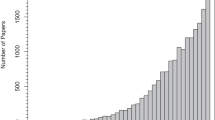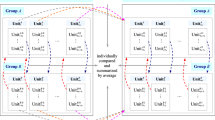Abstract
We employ data envelopment analysis (DEA) methods to construct the world production frontier, which is in turn used to decompose (labor) productivity growth into components attributable to technological change (shift of the production frontier), efficiency change (movements toward or away from the frontier), physical capital deepening, and human capital accumulation over the 1965–2007 period. Using this decomposition, we provide new findings on the causes of polarization (the emergence of bimodality) and divergence (increased variance) of the world productivity distribution. First, unlike earlier studies, we find that efficiency change is the unique driver of the emergence of a second (higher) mode. Second, while earlier studies attributed the overall change in the distribution exclusively to physical capital accumulation, we find that technological change and human capital accumulation are also significant factors explaining this change in the distribution (most notably the emergence of a long right-hand tail). Robustness exercises indicate that these revisions of earlier findings are attributable to the addition of (more recent) years and a much greater number of countries included in our sample. We also check to see whether our results are changed by a correction for the downward bias in the DEA construction of the frontier, concluding that these corrections affect none of our major findings (essentially because the level correction roughly washes out in changes.)










Similar content being viewed by others
Notes
This notion is much narrower than the polarization concept studied in the microeconomic analysis of the distribution of income. The latter concept (see, e.g., Duclos et al. 2004) is much richer, entailing psychological notions like alienation and within-group identification. Our usage, however, is consistent with that in the macroeconomic literature (see, e.g., Quah 1997).
Bimodality could be the result of convergence clubs, but bimodality is neither necessary nor sufficient for club convergence, as pointed out by Pittau et al. (2010), Battisti and Parmeter (forthcoming), and others. For examples that look at movements between groups see Bianchi (1997) and Henderson et al. (2008).
The idea behind Diewert’s sequential production set is that it represents the “state of technological knowledge” at a point in time, which is assumed not to depreciate: that is, technological innovations cannot be “forgotten” in subsequent years. Kumar and Russell (2002) did not impose this restriction—they used only current-period data to construct the current-period production frontier—and found some implosion of the frontier at low levels of capitalization. Following HR, we believe it is more reasonable to preclude such implosion.
While there are several approaches to efficiency measurement, DEA is one of the most commonly employed. The other frequently employed method is Stochastic Frontier Analysis (SFA). For comparisons of these two approaches, see, for example, Gong and Sickles (1992); Bojanic et al. (1998); Cubbin and Tzanidakis (1998); Badunenko et al. (2012), and Park and Lesourd (2000).
We drop the i subscript from e it , defined in Eq. (2), for better readability.
Unlike HR and many other studies in this area, we adopt the view of Caselli (2005) that some oil-rich countries are among the most productive in the world and should be retained in the sample.
This finding is also consistent with the Basu and Weil (1998) approach to modeling the growth process, in which each level of capitalization is associated with a unique “appropriate technology”, and technological innovations in a country are aimed at improving productivity in that country’s region of input space. See also Los and Timmer (2005).
More systematic comparisons are discussed in the robustness tests in Sect. 5.
For all estimated distributions, we employ a Gaussian kernel and the Sheather and Jones (1991) method for choice of the optimal bandwidth.
Percentages are obtained by subtracting 1 from the index and multiplying by 100. Because of compounding, the contributions of individual components do not, of course, sum to the total productivity change.
The corresponding median contributions in HR are −1, 1.5, 29.4, and 14.7.
We should note that there were large efficiency improvements in Ghana.
The p value in HR is obtained using the standard Silverman test, which has been shown to be conservative, in the sense that the true asymptotic level is less than the nominal one. When employing the calibrated Silverman test with the original HR data and set-up, the p value is equal to 0.028. Therefore the null that the counterfactual distribution incorporating only efficiency changes is uni-modal is rejected using the calibrated test for the HR sample as well.
The long tails in these distributions are attributable to exceptionally large productivity values for a few countries: especially Luxembourg and Singapore, and to a lesser extent, Hong Kong, Norway, and Ireland.
The omitted countries, none of which determines the shape of the production frontier in 1965 or 2007, are Germany, Dominican Republic, and Yugoslavia.
We thank a referee for drawing our attention to this possibility.
The USA efficiency score increases to 0.99, compared to 0.74 in the original sample.
References
Afriat SN (1972) Efficiency estimation of production functions. Int Econ Rev 13:568–598
Allen RC (2012) Technology and the great divergence. Explor Econ Hist 49(1):1–16
Badunenko O, Henderson DJ, Kumbhakar SC (2012) When, where and how to perform efficiency estimation. J R Stat Soc Ser A 175(4):863–892
Badunenko O, Henderson DJ, Zelenyuk V (2008) Technological change and transition: relative contributions to worldwide growth during the 1990s. Oxf Bull Econ Stat 70(4):461–492
Barro RJ, Lee J-W (2010) A new data set of educational attainment in the world, 1950–2010, NBER working papers 15902. National Bureau of Economic Research, Inc. http://ideasrepecorg/p/nbr/nberwo/15902html
Basu S, Weil DN (1998) Appropriate technology and growth. Q J Econ 113(4):1025–1054
Battisti M, Parmeter C (forthcoming) Income polarization, convergence tools and mixture analysis. J Macroecon. http://works.bepress.com/parms/31
Bianchi M (1997) Testing for convergence: evidence from non-parametric multimodality tests. J Appl Econ 12:393–409
Bojanic AN, Caudill SB, Ford JM (1998) Small-sample properties of ML, COLS, and DEA estimators of frontier models in the presence of heteroscedasticity. Eur J Oper Res 180(1):140–148
Brynjolfsson E, Hitt LM (2000) Beyond computation: information technology, organizational transformation and business performance. J Econ Perspect 14:23–48
Caselli F (2005) Accounting for cross-country income differences. In: Aghion P, Durlauf S (eds) Handbook of economic growth, Vol 1A, chapter 9. Elsevier, Amsterdam, pp 679–741
Caselli F, Feyrer J (2007) The marginal product of capital. Q J Econ 122(2):535–568
Charnes A, Cooper WW, Lewin AY, Seiford LM (1994) Data envelopment analysis: theory, methodology, and application. Kluwer Academic, Boston
Cubbin J, Tzanidakis G (1998) Regression versus data envelopment analysis for efficiency measurement: an application to the England and Wales regulated water industry. Util Policy 7(2):63–119
Diewert WE (1980) Capital and the theory of productivity measurement. Am Econ Rev 70(2):260–267
Duclos J-Y, Esteban J, Ray D (2004) Polarization: concepts, measurement, estimation. Econometrica 72:1737–1772
Enflo K, Hjertstrand P (2008) Relative sources of european regional productivity convergence: a bootstrap frontier approach. Reg Stud 42(10):1–17
Fan Y, Ullah A (1999) On goodness-of-fit tests for weakly dependent processes using kernel method. J Nonparametr Stat 11(1–3):337–60
Färe R, Grosskopf S, Lovell CAK (1985) Production frontiers. Kluwer-Nijhoff, Boston
Färe R, Grosskopf S, Lovell CAK (1994) The measurement of efficiency of production. Cambridge University Press, New York
Farrell MJ (1957) The measurement of productive efficiency. J R Stat Soc Ser A 120(3):253–290
Galor O (1996) Convergence? inferences from theoretical models. Econ J 106:1056–1096
Gong B-H, Sickles R (1992) Finite sample evidence on the performance of stochastic frontiers and data envelopment analysis using panel data. J Econom 51(1–2):259–284
Hall P, York M (2001) On the calibration of Silverman’s test for multimodality. Stat Sin 11:515–536
Hall RE, Jones CI (1999) Why do some countries produce so much more output per worker than others. Q J Econ 114(1):83–116
Henderson DJ, Parmeter CF, Russell RR (2008) Modes, weighted modes and calibrated modes: evidence of clustering using modality tests. J Appl Econ 23:607–638
Henderson DJ, Russell RR (2005) Human capital and convergence: a production-frontier approach. Int Econ Rev 46(4):1167–1205
Henderson DJ, Zelenyuk V (2007) Testing for (efficiency) catching-up. South Econ J 73(4):1003–1019
Heston A, Summers R, Aten B (2006) Penn world table version 6.2, Center for International Comparisons of Production, Income and Prices at the University of Pennsylvania, Philadelphia
Hulten C, Wykoff FC (1996) Issues in the measurement of economic depreciation. Econ Inq XXXIV(1):337–360
Kim J-I, Lau LJ (1994) The sources of economic growth of the East Asian newly industrialized countries. J Jpn Int Econ 8:235–271
Kneip A, Simar L, Wilson PW (2008) Asymptotics for DEA estimators in non-parametric frontier models. Econ Theory 24:1663–1697
Koopmans TC (1951) Activity analysis of production and allocation. Physica-Verlag, Heidelberg
Kumar S, Russell RR (2002) Technological change, technological catch-up, and capital deepening: relative contributions to growth and convergence. Am Econ Rev 92(3):527–548
Li Q (1996) Nonparametric testing of closeness between two unknown distribution functions. Econ Rev 15:261–274
Los B, Timmer MP (2005) The appropriate technology explanation of productivity growth differentials: an empirical approach. J Dev Econ 77(2):517–531
Pagan A, Ullah A (1999) Nonparametric econometics. Cambridge University Press, Cambridge
Park S-U, Lesourd J-B (2000) The efficiency of conventional fuel power plants in South Korea: a comparison of parametric and non-parametric approaches. Int J Prod Econ 63(1):59–67
Pittau MG, Zelli R, Johnson PA (2010) Mixture models, convergence clubs, and polarization. Rev Income Wealth 56(1):102–122
Psacharopoulos G (1994) Returns to investment in education: a global update. World Dev 22:1325–1343
Quah D (1993) Galton’s fallacy and tests of the convergence hypothesis. Scand J Econ 95(4):427–443
Quah D (1996) Twin peaks: growth and convergence in models of distribution dynamics. Econ J 106(437):1045–1055
Quah D (1997) Empirics for growth and distribution: stratification, polarization, and convergence clubs. J Econ Growth 2(1):27–59
Sheather SJ, Jones MC (1991) A reliable data based bandwidth selection method for kernel density estimation. J R Stat Soc Ser B 53:683–990
Silverman BW (1981) Using kernel density estimates to investigate multimodality. J R Stat Soc Ser B 43:97–99
Simar L, Wilson PW (1998) Sensitivity analysis of efficiency scores: how to bootstrap in nonparametric frontier models. Manag Sci 44:49–61
Simar L, Wilson PW (2000) A general methodology for bootstrapping in non-parametric frontier models. J Appl Stat 27(6):779–802
Young A (1995) The tyranny of numbers: confronting the statistical realities of the East Asian growth experience. Q J Econ 110(3):641–680
Author information
Authors and Affiliations
Corresponding author
Electronic supplementary material
Below is the link to the electronic supplementary material.
Rights and permissions
About this article
Cite this article
Badunenko, O., Henderson, D.J. & Russell, R.R. Polarization of the worldwide distribution of productivity. J Prod Anal 40, 153–171 (2013). https://doi.org/10.1007/s11123-012-0328-5
Published:
Issue Date:
DOI: https://doi.org/10.1007/s11123-012-0328-5




